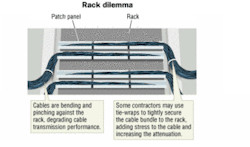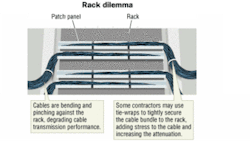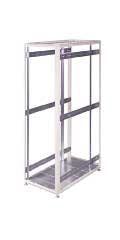Distribution racks may be sturdy and reliable, but analysts say changes are afoot as end users require racks that provide mounting space for higher density and higher wattage components.
The next generation of distribution racks are designed to be easier to set up, and can function in an increasingly small telecom room or closet. End users are also pushing manufacturers to make racks that have heightened cable management capabilities, including greater cable routing flexibility that can lead to improved network reliability.
Specifically, contractors and end users interviewed by Cabling Installation & Maintenance say they are searching for racks that will prevent cables from gaining improper bend radius. They want racks that offer flexibility, with interchangeable parts that can be used with other manufacturers' products.
"We are selling to two markets," says Lars Larsen, product manager for Ortronics, Inc. (www.ortronics.com), based in New London, CT. "We've got installation people who want a well-designed rack to let them install a permanent cable quickly and safely, and then the end-user market must live with it and be able to use it for MACs (moves, adds and changes) in the next 10 years. They want it well designed for front cable management."
"Racking is a system,"agrees Mark Tracy, director of marketing for Middle Atlantic Products Inc. (www.middleatlantic.com), based in Riverdale, NJ. "It can't be an afterthought. You need to think about the end result."
Contractors add that end users need to be wary of subtle differences as they choose a rack. "You have to do research and match up to what the user needs," says Chris Sheldon, an RCDD/LAN specialist and principal for the telecommunications group for Hargis Engineers, Inc. (www.hargis.biz), based in Seattle, WA.
What they do
Distribution racks are cable management devices that have many of the same elements as an enclosed cabinet. Racks provide the strength of an enclosure, minus side walls and a doorway. Like enclosures, racks provide mounting space for cabling equipment.
Racks are made of steel or extruded aluminum, and typically feature two sturdy base angle plates attached to two vertical channels that can be bolted to the floor. They come in free-standing or wall-mount designs, and have either two or four posts. Racks can have EIA-310 Standard compliant panels and other equipment mounted on them.
Manufacturers say the four-post rack is gaining in popularity because most work well with raised-floor applications and can handle increasingly heavy equipment. Similarly, the equipment mounting rails of the NetFrame, made by Panduit Corp. (www.panduit.com), based in Tinley Park, IL, have individual rack space markings and numbers to aid in installation.
Racks are designed to mount organizers for the proper routing of horizontal and backbone cabling and patch cords. Most are designed to provide at least some degree of cable management, as well as cooling devices that will deal with thermal issues. Racks comply with TIA/EIA (www.tiaonline.org) standards regarding height, width and seismic protection, and usually provide a means for electronically bonding and grounding. According to the EIA standard, racks must come with a load-bearing capability of 600 to 1,000 pounds.
Racks are used to manage distribution cables that run to workstations, servers or a data center. The front can be used to hold patch panels, and equipment control offices are used to mount servers, routers, switches, fuse panels and other equipment.
Racks adhere to the EIA-310D standard, which specifies their dimensions. This includes the width of the opening that equipment must pass through, down to the threaded mounting hole pattern that can be used to mount panels and equipment. Racks are typically about seven feet tall. They are between 19 and 24 inches wide, measuring from rail to rail.
Rack evolution
This is where the similarities tend to end, however. Manufacturers, after gaining feedback from contractors, say they are aggressively trying to build racks that are both simple to handle and easy to use once they have been installed. "You can't make these so that only highly-skilled, highly-paid guys can do the mission critical work," says Rob Baxter, director of datacom marketing for Hubbell Premise Wiring (www.hubbell-premise.com), based in Stonington, CT. "They (contractors) need to be able to use junior teckies for (installing) racks."
The TS8 Open Frame rack made by Rittal Corp. (www.rittal-corp.com), based in Springfield, OH, for example, now features a repeating hole pattern in its frame, showing installers where to mount equipment and gear. Chatsworth Products Inc. (www.chatsworth.com), based in West Lake Village, CA, makes universal racks that have numbered mounting units to guide installers.
"It is a feature requested by installers and designers, and it helps them instruct or tell the contractors exactly where they want the equipment mounted," says Michael Hill, product manager for Chatsworth Products.
"With the NetFrame, we incorporated cable management into it to aid in the installation," says Mark Canty, product development manager for Panduit's Rack Systems.
Rack design is evolving as manufacturers confront changes in equipment weight, depth and heat output. The weight driver comes from the servers, routers and other equipment that are becoming increasingly deeper and heavier, putting strain on racks. In fact, racks are expected to accommodate more of this equipment than ever before.
A year ago, racks were typically 36 inches deep. Today, a 40-inch-deep rack is more common—and pushing the weight-bearing capabilities as far as they can go. Panduit's NetFrame, for example, has been tested to 1,500 pounds.
"We find that more and more, our customers are trying to make better use of their real estate, packing in more equipment in the same area," says Todd Suddreth, business development manager for racks and cable management at Panduit. "With that is added weight."
Common problems
While contractors agree that these are changes for the better, there are still common problems to be overcome—including more equipment in reduced space.
In the past, end users could place racks in large, spacious data centers. But today's data centers are much smaller and crammed with a variety of equipment. Telecom rooms—or even smaller telecom closets—are notoriously cramped and crowded. And the amount of room is shrinking. "It's a double-edged sword," says Larsen. "They need more room to do what they are trying to do, but they are getting less and less."
Rack manufacturers say one of their biggest challenges is educating architects to think of how data systems, including racks, will be given proper space. "We've seen the space allocated to the racks, and it seems to be decreasing at an alarming rate," says Tracy. "The equipment closets are very crowded, and there are often other things mounted on the closet, like termination blocks."
Manufacturers like Middle Atlantic Products are trying to develop racks that can do the job in as little space as possible. The company's Swing-Frame Rack, for example, does not have a backing to it, and is supported by two structural members on its side that provide four-point mounting. The rack can be mounted over other obstacles that are already mounted on the wall, effectively doubling the use of existing space.
But the space problem isn't limited to the area outside the rack. Some racks fail to offer adequate room for equipment and cable management products. Even as racks become more congested, the market is calling for greater cable and component density. Switches are being built with more ports, going from 24 to 48 ports in one rack unit. This port doubling is leading to more patch cords connected to the front of each rack. Many racks also now contain a midspan solution that is used to inject Power over Ethernet. All of this takes up more space on the rack, making it harder for an installer or IT manager to tackle potential MACs.
"There is not much room for cable management," says Phillip Dunn, product manager of IT products for Rittal Corp. "People get into the hubs and routers, and you get 1,000 cables coming into the cabinet. It can be hard to find a defective cable."
Al Cioffi, vice president of business development and product management for Valere Power (www.valerepower.com), based in Richardson, TX, says that installers often have to resort to using cable ties to neatly pull a cable along the edges of a congested rack. This is problematic on two levels, he says. First, the end result is unappealing. "The solutions today aren't aesthetically pleasing," says Cioffi.
But the problem goes deeper than that. Sheldon of Hargis Engineers says many of today's racks do not have adequate channels through which to draw cables. The problems begin when the cable is fed down into the rack vertically, eventually terminating to the patch panel and causing a poor bend radius that leads to poor transmission quality. It's a problem, he says, that he has encountered too often during the past year.
"If the cable quality is to be maintained, the way the cables come down, they have to be supported," says Sheldon. "If the vertical channels don't have the capacity, it adds stress due to the bending of the cables. And that can be damaging."
Sheldon says a well-designed rack will prevent this problem by providing vertical channels that let installers properly rout the cable and avoid bend radius problems.
Some manufacturers are trying to address this problem. Racks made by Telect (www.telect.com), based in Liberty Lake, WA, for example, now have an open-framed design intended to provide protection for cable bend radius. Ortronics manufactures racks that provide vertical cable managers that give end users three or four different styles of vertical cable management through rings that can be mounted in the front, and through vertical channels. These steps are designed to separate the distribution cables from the patch cabling.
Heat dissipation
Thermal management is enhanced when an open two-post or four-post rack is used. But heat dissipation remains a concern for many end users, and contractors say the next generation of distribution racks need to be equipped to tackle this problem.
The growing popularity of Power over Ethernet, meanwhile, is only leading to higher rack temperatures on racks. Chatsworth's Hill says its causing manufacturers to concentrate more on cooling devices. "It (Power Over Ethernet) triples the wattage, and increases the emphasis on thermal management products," says Hill.
Distribution racks may be sturdy and reliable, but analysts say changes are afoot as end users require racks that provide mounting space for higher density and higher wattage components.
Many manufacturers are now customizing their racks to deal with this problem. Ortronics' Mighty Mo, for instance, now features ventilation slots on its vertical channels to accommodate heat build-up.
Click here to download Providers of Distribution racks table (pg. 53) as pdf. {pdf size=512K}
Brian Miligan is senior associate editor for Cabling Installation & Maintenance.


